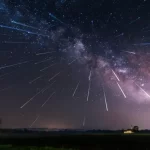Key Takeaways:
- Move over black holes; ‘White Holes’ are here to challenge our cosmic understanding.
- White holes are the antithesis of black holes, spewing matter into space instead of engulfing it.
- Astrophysicists have been exploring the concept of white holes since the 1970s.
- Despite being purely theoretical, some events, such as gamma-ray bursts, have been proposed as potential white holes.
- The existence of white holes, if ever observed, could revolutionize our understanding of the Universe.
The universe, with its myriad mysteries, has long captivated our curiosity, and among its enigmatic phenomena, black holes have held a prominent place. These collapsed cores of dead stars, known for devouring everything in their vicinity, have a cosmic counterpart that challenges our understanding – the elusive ‘white holes.’
Imagine delving into the intricacies of space-time around a black hole, subtracting the collapsed star’s mass, and unveiling the mathematical description of a white hole – a massless singularity. Unlike their gravitational counterparts, black holes, where matter disappears into an event horizon, white holes defy entry. They expel matter at an astonishing rate, akin to hitting a cosmic ‘rewind’ button.
Theoretical musings on white holes have been ongoing since the 1970s. In the absence of a preferred direction of time in general relativity’s field equations, if black hole formation is permissible, so too are white holes, according to Erik Curiel.
Despite their theoretical existence, observing a white hole remains elusive. Astrophysicists question their formation process, contemplating the possibility of the universe starting with pre-existing singularities, a notion deemed unconventional.
Ignoring these challenges, let’s ponder a hypothetical scenario where a white hole emerges. The math suggests that no matter can coexist within the space-time containing a black hole. If any matter enters, even minutely, the white hole ceases to exist promptly.
While white holes remain theoretical, so too were black holes until recently. Some propose that gamma-ray bursts, incredibly bright cosmic events, might be candidate white holes. The 2017 observation of a burst resulting from the collision of neutron stars fueled this speculation.
A more audacious idea suggests the Big Bang itself could have been a supermassive white hole. Mathematically explored, this notion challenges the conventional understanding of the universe’s explosive origins.
Further speculation arises about white holes emerging at the end of a black hole’s lifespan, potentially constituting a component of dark matter. These concepts, though intriguing mathematically, lack empirical evidence in our observable universe.
The potential discovery of a white hole would prompt a profound reevaluation of our cosmic comprehension. As we continue to unravel the universe’s mysteries, the prospect of encountering a white hole promises to be an exhilarating leap into the unknown, challenging our fundamental understanding of the cosmos.


